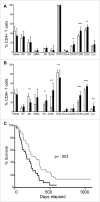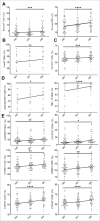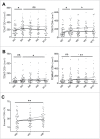Ipilimumab reshapes T cell memory subsets in melanoma patients with clinical response
- PMID: 27622012
- PMCID: PMC5006913
- DOI: 10.1080/2162402X.2015.1136045
Ipilimumab reshapes T cell memory subsets in melanoma patients with clinical response
Abstract
Purpose: Therapy targeting CTLA-4 immune checkpoint provides increased survival in patients with advanced melanoma. However, immunotherapy is frequently associated with delayed and heterogeneous clinical responses and it is important to identify prognostic immunological correlates of clinical endpoints.
Experimental design: 77 patients with stage III/IV melanoma were treated with ipilimumab alone every 3 weeks, during 9 weeks. Blood samples were collected at the baseline and before each dose for in depth immune monitoring.
Results: The median follow-up was 28 mo with a median survival of 7 mo. Survival and clinical benefit were significantly improved when absolute lymphocyte count at the baseline was above 1 × 10(9)/L. Notably, ipilimumab had a global effect on memory T cells, with an early increase of central and effector subsets in patients with disease control. By contrast, percentages of stem cell memory T cells (TSCM) gradually decreased despite stable absolute counts and sustained proliferation, suggesting a process of differentiation. Higher proportions of eomes(+) and Ki-67(+) T cells were observed, with enhanced skin homing potential and induction of cytotoxic markers.
Conclusion: These results suggest that CTLA-4 blockade is able to reshape the memory subset with the potential involvement of Eomes and memory subsets including TSCM.
Keywords: CTLA-4; TSCM; immunotherapy; ipilimumab; melanoma; memory T cells.
Figures





Similar articles
-
T-Cell Therapy Using Interleukin-21-Primed Cytotoxic T-Cell Lymphocytes Combined With Cytotoxic T-Cell Lymphocyte Antigen-4 Blockade Results in Long-Term Cell Persistence and Durable Tumor Regression.J Clin Oncol. 2016 Nov 1;34(31):3787-3795. doi: 10.1200/JCO.2015.65.5142. J Clin Oncol. 2016. PMID: 27269940 Free PMC article.
-
High cytotoxic T-lymphocyte-associated antigen 4 and phospho-Akt expression in tumor samples predicts poor clinical outcomes in ipilimumab-treated melanoma patients.Melanoma Res. 2017 Feb;27(1):24-31. doi: 10.1097/CMR.0000000000000305. Melanoma Res. 2017. PMID: 27768639
-
Prognostic factors and outcomes in metastatic uveal melanoma treated with programmed cell death-1 or combined PD-1/cytotoxic T-lymphocyte antigen-4 inhibition.Eur J Cancer. 2017 Sep;82:56-65. doi: 10.1016/j.ejca.2017.05.038. Epub 2017 Jun 22. Eur J Cancer. 2017. PMID: 28648699
-
Ipilimumab targeting CD28-CTLA-4 axis: new hope in the treatment of melanoma.Curr Top Med Chem. 2012;12(1):61-6. doi: 10.2174/156802612798919231. Curr Top Med Chem. 2012. PMID: 22196270 Review.
-
Overcoming immunologic tolerance to melanoma: targeting CTLA-4 with ipilimumab (MDX-010).Oncologist. 2008;13 Suppl 4:16-25. doi: 10.1634/theoncologist.13-S4-16. Oncologist. 2008. PMID: 19001147 Review.
Cited by
-
Biomarkers, measured during therapy, for response of melanoma patients to immune checkpoint inhibitors: a systematic review.Melanoma Res. 2019 Oct;29(5):453-464. doi: 10.1097/CMR.0000000000000589. Melanoma Res. 2019. PMID: 30855527 Free PMC article.
-
Dual blockade immunotherapy targeting PD-1/PD-L1 and CTLA-4 in lung cancer.J Hematol Oncol. 2024 Jul 27;17(1):54. doi: 10.1186/s13045-024-01581-2. J Hematol Oncol. 2024. PMID: 39068460 Free PMC article. Review.
-
Mechanisms of response and resistance to combined decitabine and ipilimumab for advanced myeloid disease.Blood. 2023 Apr 13;141(15):1817-1830. doi: 10.1182/blood.2022018246. Blood. 2023. PMID: 36706355 Free PMC article.
-
Peripheral T Cell Subpopulations as a Potential Surrogate Biomarker during Atezolizumab plus Bevacizumab Treatment for Hepatocellular Carcinoma.Cancers (Basel). 2024 Mar 28;16(7):1328. doi: 10.3390/cancers16071328. Cancers (Basel). 2024. PMID: 38611007 Free PMC article.
-
Specific Patterns of Blood ILCs in Metastatic Melanoma Patients and Their Modulations in Response to Immunotherapy.Cancers (Basel). 2021 Mar 22;13(6):1446. doi: 10.3390/cancers13061446. Cancers (Basel). 2021. PMID: 33810032 Free PMC article.
References
-
- Garbe C, Eigentler TK, Keilholz U, Hauschild A, Kirkwood JM. Systematic review of medical treatment in melanoma: current status and future prospects. Oncologist 2011; 16:5-24; PMID:21212434; http://dx.doi.org/10.1634/theoncologist.2010-0190 - DOI - PMC - PubMed
-
- Balch CM, Gershenwald JE, Soong SJ, Thompson JF, Atkins MB, Byrd DR, Buzaid AC, Cochran AJ, Coit DG, Ding S et al.. Final version of 2009 AJCC melanoma staging and classification. J Clin Oncol: Off J Am Soc Clin Oncol 2009; 27:6199-206; PMID:19917835; http://dx.doi.org/10.1200/JCO.2009.23.4799 - DOI - PMC - PubMed
-
- Lotze MT, Rosenberg SA. The immunologic treatment of cancer. CA: Cancer J Clin 1988; 38:68-94; PMID:2450624; http://dx.doi.org/10.3322/canjclin.38.2.68 - DOI - PubMed
-
- Rosenberg SA, Packard BS, Aebersold PM, Solomon D, Topalian SL, Toy ST, Simon P, Lotze MT, Yang JC, Seipp CA et al.. Use of tumor-infiltrating lymphocytes and interleukin-2 in the immunotherapy of patients with metastatic melanoma. A preliminary report. New Engl J Med 1988; 319:1676-80; PMID:3264384; http://dx.doi.org/10.1056/NEJM198812223192527 - DOI - PubMed
-
- Lee S, Margolin K. Tumor-infiltrating lymphocytes in melanoma. Curr Oncol Rep 2012; 14:468-74; PMID:22878966; http://dx.doi.org/10.1007/s11912-012-0257-5 - DOI - PMC - PubMed
Publication types
LinkOut - more resources
Full Text Sources
Other Literature Sources
